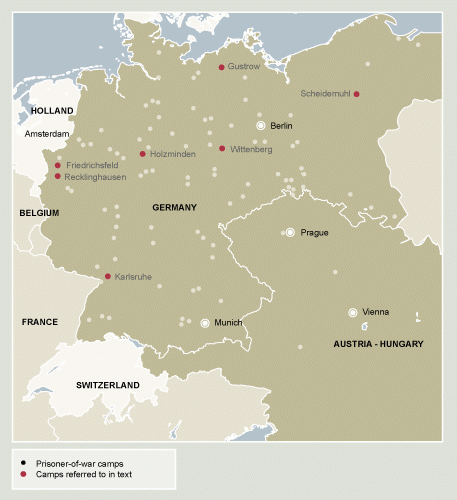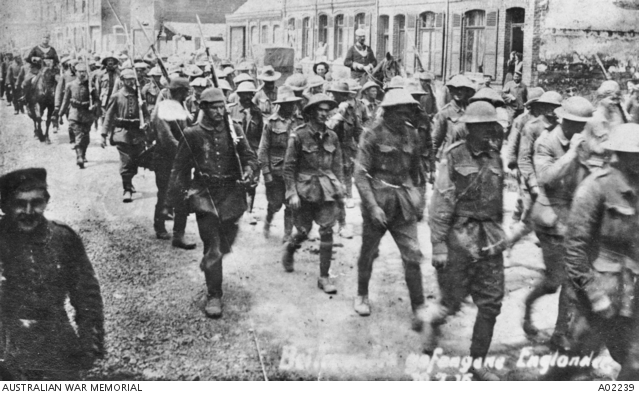Stolen Years: Australian prisoners of war - Prisoners of the Germans
“One slice of bread in the morning”
I am a Kriegsgefangener
I wish that I were dead
It’s all through drinking sauerkraut
And eating mouldy bread.
Written by a Kriegsgefangener – a prisoner of war

Nearly 4,000 Australians were captured by the Germans on the Western Front, in France and Belgium between 1916 and 1918.
The conditions they endured varied greatly. In 1917 many were held in appalling conditions in Fort MacDonald near Lille, in Belgium, despite the Hague Convention on the treatment of prisoners of war. Others, often starved and treated brutally, worked for months under shellfire close behind German lines.
In camps in Germany conditions were better, but prisoners suffered increasingly from shortages caused by the British blockade. Many survived only because of regular Red Cross parcels.
Of the 3,853 Australians captured by the Germans, 310 – about one in 12 – died in captivity.
Wounded Australians waiting to be treated by the Germans after the disastrous attack at Fromelles, July 1916.
Forced labour behind the lines
The Germans … put us in a fort at Lille. They never gave us anything. We may have had a slice of bread a day, nothing else. We were building dugouts, huts, carrying and loading shells. We had one slice of bread in the morning and at lunchtime a pot of soup, which was more or less like water.
Private Horace Ganson, 16th Battalion, AIF, captured at Bullecourt
Australian and British troops captured on the Somme in 1916. Many of these men were forced to work close to the German trenches, sometimes under artillery fire, in contravention of the Hague Convention on the treatment of prisoners of war. An Australian soldier found this photograph in a German trench later in the war.
Holzminden
Officer camp, Gustrow, Germany, 1918: The “Bing Boys”, a theatrical troupe. “The Germans were highly delighted with our entertaining … and always insisted on us getting them photographed.”
Officer camp, Karlsruhe, Germany, 1917: The “home” of two Australian officers and a Belgian fellow prisoner.
Officer camp, Karlsruhe, Germany, 1917: The officers’ barracks where eight men, attended by French soldier-servants, shared a room.
Red Cross
“Dear Miss Chomley”
Mary Elizabeth Chomley, an Australian living in London, ran the Red Cross prisoner-of-war office in London that supported Australian prisoners in Europe. For thousands of Australians in German camps, Miss Chomley’s parcels reminded them that they had not been forgotten. Her album and the Red Cross records in the Memorial contain hundreds of letters and cards thanking her for her work.
“It has been a matter of great wonder that the Germans, when in straits for food, allowed these parcels to reach us.” Prisoners unloading Red Cross parcels at Scheidemühl camp, near Posen in eastern Germany, December 1917.
British women volunteers packing Red Cross “comforts” parcels in London, in 1918, for Australian prisoners in Germany. A prisoner later wrote, “You Red Cross workers … the contents of your parcels saved many a prisoner’s life.”
Douglas Grant “ An unmistakable figure”
Douglas Grant had been adopted by a white family at the age of two in 1881. He enlisted in 1916 but was discharged because Aboriginal people were not allowed to serve. He later succeeded in enlisting, joined the 13th Battalion, AIF, and was captured at Bullecourt in April 1917.
He enjoyed unusual freedom. In Berlin, German anthropologists were more interested in studying him than in imprisoning him. A talented artist, he impressed his captors with his intellect. A German scientist described Grant as “an unmistakable figure”, recalling how prisoners appointed him to take charge of relief parcels because of “his honesty, his quick mind, and because he was so aggressively Australian”.
After returning to Australia, though, Douglas Grant could not find work to match his skills. He died in 1951, depressed and frustrated, unable to fit easily into either white or black society.







